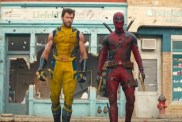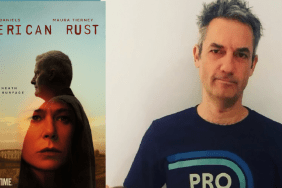An interview with Almost Human’s Rob Hall
More coverage from The Crazies: Set Report | Director Breck Eisner Interview | Timothy Olyphant Interview | Radha Mitchell Interview | Joe Anderson Interview | Danielle Panabaker Interview

This is where they stash the bodies. And it’s not a pretty scene. These two corpses are ripe, bloated masses of tattered clothes, congealed blood and other body fluids – both housed in the trailer of Almost Human FX. The wonderfully macabre aspect of this rolling meat locker is that it’s just a stone’s throw away from Georgia’s Peach Country High School where The Crazies – a remake of the â73 George Romero film of the same name – has set up production when Shock Till You Drop visits the set. Inside, accompanied by not just his convincing dead guys but equally convincing FX photographs of the film’s “infected” too, we find Almost Human top dog Rob Hall, who, these days, appears to be the go-to guy if you need someone to create victims of a viral pandemic. In 2008, the Dowdle brothers called upon him for Quarantine; but Hall is quick to tell us that he’s not out to repeat himself and in this Breck Eisner-directed update we can expect a new vision of the “crazies” – residents of Ogden Marsh and victims of their contaminated water supply.
ShockTillYouDrop.com: You’re a horror fan, how does this update hold up?
Rob Hall: What I appreciate about the script of this movie is it’s actually pretty awesome. It extrapolates a lot on the themes that Romero had, but it definitely currents it and not in a stupid, dumbed-down, PG-13 way. It actually takes it and amps up the violence, amps up the infection, and amps up the horror of it which I think is needed. So I appreciate the tone of it. It’s a lot darker, I think, than the original movie.
Shock: Were you worried that you would be asked to replicate something that was like what you did in Quarantine?
Hall: The Quarantine connection was definitely a concern. I think it helped me in my meetings with Breck originally and then it worried maybe him a little bit because he wanted to make sure that we were doing something completely different. I showed him a lot of the designs that we did in Quarantine. The approach for this, Breck spearheaded. He definitely came to the table with a year’s-worth of research that he wanted to take a lot of these real viruses – tetanus, and rabies, and Stevens-Johnson syndrome, which I think apparently I’m suffering from. There’s a lot of skin lesions, like micro mycosis, and a lot of really weird stuff. He had had a lot of that stuff and brought it to the table and said, “Can you do an amalgam of this stuff? Let’s see what it looks like.” There was not really a concern after I showed him, “This is where we went with Quarantine and this is where we can take this.”

Shock: The rabies baby video that you guys were watching in Quarantine, did all of these guys see that too? Was that as big of an impact?
Hall: Breck wouldn’t watch that. He wouldn’t watch it, but he showed me some equally as disgusting things for sure.
Shock: Two girls, one cup?
Hall: [laughs] I love that one. To be honest I feel like the rabies element of the Trixie virus in this is downplayed a lot because Quarantine was pretty much a deadly strain of rabies. There’s been a really conscious effort here to really stay clear of that movie, to stay clear of zombies. Our guys aren’t dead, they’re full of this virus. It’s almost like they’re the opposite of dead, it’s almost like there’s too much life in them so they’re bursting at the seams. Their faces are red and there’s blood blisters and there’s veins and they’re very vascular. I think that it’s the opposite of being dead. So that’s what we strived to do.
Shock: It’s called the Trixie virus in the script?
Hall: It’s mentioned, I think, only once in this version of the movie. I think it’s mentioned a lot in the other movie because the first movie had all of that exposition of the sergeants, and generals, and military people yelling at each other. All of that stuff. And then, that’s the one thing in this they definitely took out which was probably pretty wise because it keeps everything moving.
Shock: You combine these three viruses into a virus that doesn’t exist. So, how do you map that progression?
Hall: There’s a certain amount of medical accuracy that you have to have and then there’s a certain amount of cinematic expectations. I think it’s hovering between all that stuff. But we did really try to take it and extrapolate on the real diseases and say, âOkay, well this disease has a little bit of this when it gets late and it starts to get evolved so we can introduce a little bit of that as well and then we can introduce a little bit of this.” We pretty much kept it really consistent in terms of what the actual diseases that we mentioned before do and then we combine it all and play with it a little bit.

It’s interesting. It’s definitely not slow and sluggish and it’s definitely not like the rage guys in 28 Days Later. Not only are they at times a real threat, they come after you full force with guns. What’s cool about them is they retain a lot of the knowledge that the host had before. We had these characters who are these really redneck, burly hunters and when the shit hits the fan, they get infected, they’re still hunting which is a real cool. There’s obviously something eating through their brain, but they retain whatever they did in their uninfected life and carry that through which I think is one of the differences of this film.
Shock: When you were reading the script, what kills or kill got you excited the most that you wanted to pull off?
Hall: There was a lot of really cool set pieces in the script that I was more excited about really than the kills. There’s a giant fat guy that doesn’t really have much to do with the plot, but he’s this disgusting fat dude that was killed by one of the crazies obviously and that was just a great set piece that I was really excited to build. There’s some good kills in there. There’s some good safe kills.
Shock: How vicious is the film in that respect?
Hall: It’s not Martyrs, but it’s not Prom Night. I think it’s going to be a hard “R” creepy movie. Breck’s pretty clever about the way he wants to shoot that stuff and I don’t think he is doing anything that’s really gratuitous, but he’s also not copping out if that makes any sense.
Shock: Can you tell us about your particular stamp on this movie? Did you do anything that you were psyched to do that they just let you run with it?
Hall: The big, dead fat guy, I keep going back to him, he’s fun. There’s also a really cool corpse that they pull out of the water who was a military guy. He was the beginning of how the virus got into the water. It plays into that thing which was fun. We had never made anything like a textbook bloater with the tongue all swollen and hanging out. But for the most part it’s all stuff that we’ve done – a lot of infected, f**ked up people and a lot of realistic dead bodies. But I’m always excited to do that stuff because. I think the look of the actual crazies is different which is kind of neat. They’re definitely not zombies.

Shock: What is the art of doing a dead body and making it look real?
Hall: You’re totally beholden to the filmmakers when you get on set. They’re always like, “Oh, make it more saucy, make it less, make it more.” In terms of the likeness it’s always just really important to try and capture the likeness of the person. If you don’t know who it is immediately, then you’ve got to fix it. I think that’s one of the hardest things too, like the Gary Cole body for instance in Pineapple Express was really hard for me to get the likeness down of that because he’s got such a distinct face, but also when someone’s doing an expression, it’s difficult. You want to make sure the teeth stick out exactly the way it sticks out in his reference photo when he’s making the same expression. And, the eyes are pushed in too much, it’s just a fraction of a millimeter and it looks weird. There’s a lot of finessing. It’s essentially just the whole philosophy of paint what you see. It’s the same thing with a fake head. You just have to literally look at all your references and just be like, “Okay, does it look like that? The stubble maybe needs more or needs less.” You’ve just got to keep hammering until you get that likeness. It’s tough.
The Crazies opens in theaters on February 26. Click on the title for stills, poster art and trailers!
Source: Ryan Rotten, Managing Editor










